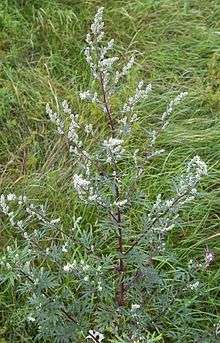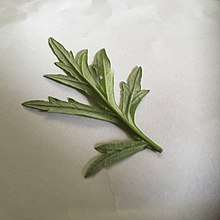Artemisia vulgaris
Artemisia vulgaris (common mugwort[2]) is one of several species in the genus Artemisia commonly known as mugwort, although Artemisia vulgaris is the species most often called mugwort. This species is also occasionally known as riverside wormwood,[3] felon herb, chrysanthemum weed, wild wormwood, old Uncle Henry, sailor's tobacco, naughty man, old man or St. John's plant (not to be confused with St John's wort).[4] Mugworts have been used medicinally and as culinary herbs.
| Artemisia vulgaris | |
|---|---|
 | |
| Scientific classification | |
| Kingdom: | Plantae |
| Clade: | Tracheophytes |
| Clade: | Angiosperms |
| Clade: | Eudicots |
| Clade: | Asterids |
| Order: | Asterales |
| Family: | Asteraceae |
| Genus: | Artemisia |
| Species: | A. vulgaris |
| Binomial name | |
| Artemisia vulgaris L. 1753 not C.B. Clarke 1882 nor Mattf. 1926 | |
| Synonyms[1] | |
|
Synonymy
| |
Distribution
Artemisia vulgaris is native to temperate Europe, Asia, northern Africa and Alaska and is naturalized in North America,[5] where some consider it an invasive weed. It is a very common plant growing on nitrogenous soils, like weedy and uncultivated areas, such as waste places and roadsides.[6]
Uses
Traditionally, it was, and is, used as one of the flavoring and bittering agents of gruit ales, a type of non-hopped, fermented grain beverage.
In Nepal, the plant also called "Titepati" (Tite meaning bitter, pati meaning plant) is use as an offering to the gods, for cleansing the environment (sweeping floors or just hanging a bunch outside your home), as an incense when burnt and also as a medicinal plant.[7]
The dried leaves are often smoked or drank as a tea to promote lucid dreaming. This supposed oneirogenic effect is believed to be due to the thujone contained in the plant.
Description
Artemisia vulgaris is a tall herbaceous perennial plant growing 1–2 m (rarely 2.5 m) tall, with an extensive rhizome system. Rather than depending on seed dispersal, Artemisia vulgaris spreads through vegetative expansion and the anthropogenic dispersal of root rhizome fragments.[8] The leaves are 5–20 cm long, dark green, pinnate and sessile, with dense white tomentose hairs on the underside. The erect stems are grooved and often have a red-purplish tinge. The rather small florets (5 mm long) are radially symmetrical with many yellow or dark red petals. The narrow and numerous capitula (flower heads), all fertile, spread out in racemose panicles. It flowers from mid-summer to early autumn.[9]
A number of species of Lepidoptera (butterflies and moths) such as Ostrinia scapulalis feed on the leaves and flowers of the plant.[10]


References
- The Plant List, Artemisia vulgaris L.
- "BSBI List 2007". Botanical Society of Britain and Ireland. Archived from the original (xls) on 23 October 2014. Retrieved 2014-10-17.
- English Names for Korean Native Plants (PDF). Pocheon: Korea National Arboretum. 2015. p. 361. ISBN 978-89-97450-98-5. Archived from the original (PDF) on 25 May 2017. Retrieved 25 January 2017 – via Korea Forest Service.
- "Ohio Perennial and Biennial Weed Guide: Mugwort Artemisia vulgaris". Ohio Agricultural Research and Development Center, Ohio State University. Archived from the original on 19 May 2011.
- "Plants profile for Artemisia vulgaris (common wormwood)". PLANTS USDA.gov.
- Barney, J. N.; DiTommaso, A. (2002). "The biology of Canadian weeds. 118. Artemisia vulgaris L." Canadian Journal of Plant Science. 83 (1): 205–215. doi:10.4141/P01-098.
- Rysdyk, Evelyn C. (19 February 2019). The Nepalese Shamanic Path: Practices for Negotiating the Spirit World. Simon and Schuster. ISBN 978-1-62055-795-2.
- New York Invasive Species Information. "Mugwort". nyis.info. Retrieved 29 October 2019.
- Parnell, J. and Curtis, T. 2012. Webb's An Irish Flora. Cork University Press. ISBN 978-185918-4783
- Calcagno, Vincent; Bonhomme, Vincent; Thomas, Yan; Singer, Michael C.; Bourguet, Denis (7 September 2010). "Divergence in behaviour between the European corn borer, Ostrinia nubilalis, and its sibling species Ostrinia scapulalis: adaptation to human harvesting?". Proceedings of the Royal Society of London B: Biological Sciences. 277 (1694): 2703–2709. doi:10.1098/rspb.2010.0433. ISSN 0962-8452. PMC 2982046. PMID 20410041.
External links
| Wikimedia Commons has media related to Artemisia vulgaris. |